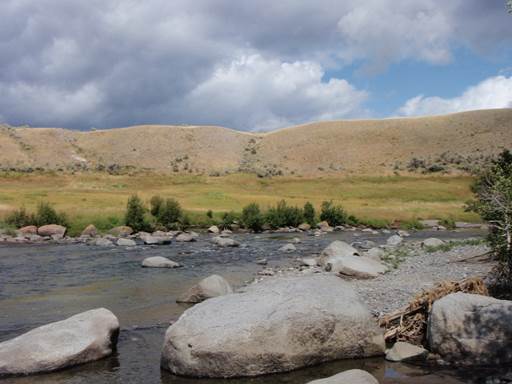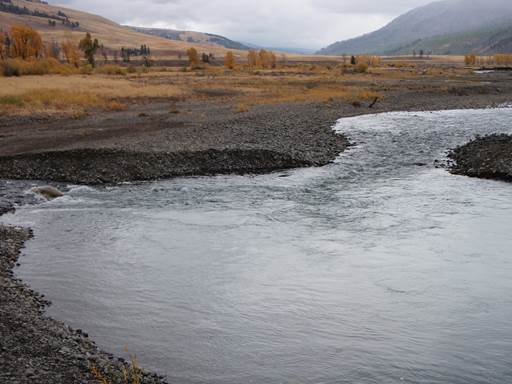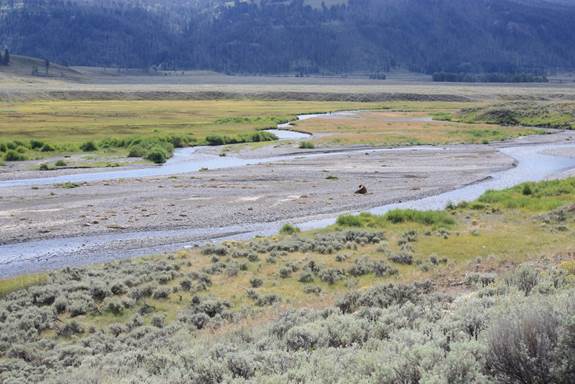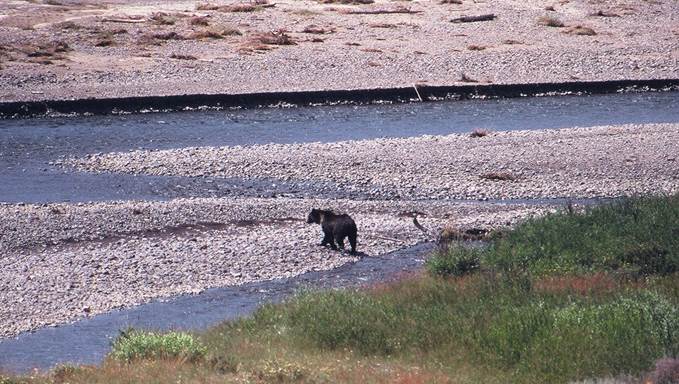THE FLY FISHING CHRONICLES OF YELLOWSTONE NATIONAL PARK - Part 1
THE LAMAR RIVER & SODA BUTTE CREEK
Approximately three million years ago the 3,472 square mile area that we call Yellowstone National Park was the site of some very violent volcanic activity. This action ultimately gave rise to the geysers, hot springs, mud pots and fumaroles. During the past 300,000 years three different Glaciers covered the region. These also contributed to the sculpturing of Yellowstone, which in turn attracts millions of people to the Park each year. Though many travel to view the natural attractions some travel to fish. In 1872 President Ulysses S. Grant signed the bill that created Yellowstone National Park. The northeast quadrant of the park contains the Lamar River and Soda Butte Creek, arguably two of the finest fisheries in the park.
THE LAMAR RIVER
The first to write of the beautiful Lamar River Valley was Osborne Russell, in his Journal of a Trapper. Russell traveled the area from 1834 to 1848. When Russell saw the Lamar River Valley he referred to it as "Paradise Valley", as many anglers would later agree. Early maps referred to the Lamar as Beaver Creek or the East fork of the Yellowstone River.
The Lamar River is named for Lucius Lamar. In 1885 Lamar was Secretary of the Interior for President Grover Cleveland. Secretary Lamar is credited for keeping the railroads and other unwanted developments such as mining out of the Park.
The Lamar River begins high in the Absaroka Mountains in Hoodoo Basin at 9,200 feet. The basin lies between Lamar Mountain and Parker Peak. For the next 30 miles the Lamar drops 3,000 feet, which is a drop of 100 feet for every mile traveled. Therefore, the upper reaches of the Lamar are only suitable for smaller fish ranging from 5 to 10 inches. The river starts to flatten out at Cache Creek, which is also the official starting point of the Lamar River Valley and runs to the head of the Lamar Canyon. The river that runs through the valley is a classic meadow stream, with riffles, pools, flats and even a few runs. Due to the steep gradients of the upper reaches of the river and the fact that it runs through glacial moraine, which is somewhat unstable, this is one of the last rivers in the park to clear from snow melt. Normally the river is fishable by mid-to-late July. In 2012 it was clear to fish in early July, so it pays to check.
During the summer, hard thunderstorms may cause the river to discolor for a day or two. The flow during run-off can reach a high of 20,000 cfs as it did in 1997 and by October be down to 200cfs. The high flows of run-off, coupled with the geological features of the terrain, means that your favorite riffle or pool may not be there next year. In the valley the river often changes with the season.
The top two miles of the canyon is pocket water filled with cascades, large boulders and fast currents. The river flattens a little a short distance above the point where Slough Creek enters and then continues down to the Yellowstone River in the Black Canyon.
The entire length of the river is 45 miles. The Lamar has excellent populations of native cutthroat trout along with some rainbows and even some cutthroat-rainbow hybrids called cut-bows. Trout vary in size from 10 to 18 inches in the valley with an occasional larger trout. The Lamar has several tributaries; Soda Butte Creek is the largest and will be covered in another section. The other tributaries are Cache Creek which is four miles upstream from Junction Pool where the Soda Butte Creek enters the Lamar. Six miles from Cache Creek is Calfee Creek and yet another mile is Miller Creek. Even further up the Lamar are Mist Creek and the Little Lamar River. There are plenty of back-country campsites, but you must check in at the Back-Country Office at the Park headquarters in Mammoth. For those who wish for solitude, you will find it in the upper reaches of the Lamar. However, once you get above Cache Creek the fish size starts to diminish and continues to do so the higher you go. The Lamar is also a favorite of wildlife and you may encounter moose, black bears, buffalo and grizzlies just to name a few. So obey the rules when traveling in the back-country.
One angler told me that he went to the Lamar and there were cars and motor homes everywhere and decided that he would avoid the crowds. Yes, both the Lamar River and Soda Butte Creek are favored by the anglers yet I have never seen it so crowded that you couldn't find reasonable fishing room. However, I have also seen the area overrun with cars and motor homes. The reason for this is besides all the natural beauty of the valley and abundance of wildlife, this valley is also home of the Gray Wolf, and Mr. Wolf draws a crowd!
FISHING THE LAMAR
The Lamar can offer the angler anything from size 2 Salmon flies to size 24 Midges depending on the season. On those years when the Lamar clears early, the fly fisher can enjoy fishing the stone fly hatch as the Lamar has an excellent hatch of Salmon Flies and Golden Stones. Next comes the Green Drakes, Gray Drakes, and PMD's, along with several species of Caddis, Midges, and Terrestrials, to name just a few.
Visiting fly fishers need to have a six weight rod along besides their light line rods. The six weight is for the wind!!! The Lamar River Valley is wide open and surrounded by mountains; hence there can be days when the wind is the biggest challenge. The six weight rod is also good for presenting the Hopper, Cricket and Stonefly imitations in the proper manner. My two favorite rod weights for both the Lamar and Soda Butte Creek are fours and sixes.
Many challenges await the visiting angler. The first of these may be hooking the cutthroat trout. Cut's are very deliberate risers and anglers are often ripping the hook out of their mouths. Also, despite their reputation for being easy, many will find the Cut's quite fussy. They often rise and float back with the imitation, carefully inspecting the offering and then return to their holding station. From the time the Lamar clears from the run-off until the Park closes for the winter the Lamar offers challenge that continues and changes with each season. As the water levels are always dropping, the trout are always adjusting their position. Therefore the angler needs to read the water to be successful. If you are not catching trout, move. You may be fishing water that isn't holding any trout.

The most popular sections of the Lamar are from junction pool (where Soda Butte Creek enters the Lamar) and the first two miles downstream. The first mile above the canyon and the top of the canyon are also very popular. The center section of the valley is often devoid of anglers. This may be due to the long walk across the open valley floor to get to the river. Yet this section holds many trout and is excellent fishing. The last few miles of the river is visited by few anglers.
Even though the Lamar has the reputation for being best suited for attractor and terrestrial imitations, it also has some very good hatches and those who are ill-prepared are often frustrated. For those who don't mind fishing with heavy nymphs and streamer imitations I suggest fishing the Lamar Canyon. In this section I have never felt crowded. I suggest having a good supply of stonefly, caddis and attractor nymphs that are suited to the heavy water of the canyon. I have also done well with streamer imitations in this section.
Now let's take a look at Soda Butte Creek which is the largest of the Lamar's tributaries.
SODA BUTTE CREEK
Whereas the Lamar River is born in the park and runs its entire course through Yellowstone National Park, Soda Butte Creek begins in Montana and then enters the Park. Soda Butte Creek begins right along highway US 212 just to the east of Cooke City, Montana.

There it flows west and southwest to where it parallels the Northeast Entrance Highway as it enters the park. It continue to flow southwest to where it joins the Lamar River at junction pool at the base of Druid Peak.
From the Park boundary to the junction with the Lamar River, Soda Butte Creek is approximately fifteen miles in length. The upper section of Soda Butte Creek meanders through timber and small meadows, where the gradient is moderate. Then the creek plunges through Ice Box Canyon and enters Round Prairie (which is a huge meadow). Here Pebble Creek and Amphitheater Creek enter Soda Butte.

Then the creek tumbles through another short canyon and from there to the Lamar it runs through a valley where the creek is braided with a number of channels. This last section is very much a classic meadow creek. The trout in the creek average between 12 to 14 inches with trout up to 22 inches being reported. While Cutthroat trout are the dominate species, one can still catch Rainbows and even a few Cut-Bows.
However, due to the creek's reputation for larger trout and the fact that the Northeast Entrance Road runs right along it, it is not the place to expect to fish with no other anglers being about. Soda Butte Creek sees a lot of anglers, yet the quality of the fishery continues, and it is rated as one of the finest small streams in Yellowstone National Park. Soda Butte Creek enjoys the same hatches as does the Lamar River.
The beauty, the wildlife and the quality of the fishing will continue to draw anglers to the Valleys of the Lamar River and Soda Butte Creek. However, there are plenty of trout and lots of room for anglers to spread out and enjoy the fishing.

In recent years the population of Grizzly Bears in Yellowstone National Park has expanded and in the past where you had a very low chance of an encounter on Soda Butte Creek or the Lamar that is no longer the case. Therefore anglers need to be prepared with whistles and bear spray and to fish with an awareness of your surroundings.
The Northeast corner of the Yellowstone Park has also become very popular with the wildlife enthusiasts that are hoping to photograph the wolves, grizzly bears and the buffalo, this park of the park has become a favored location for this type of activity. This doesn't bother the fishing; it does however make the traffic a little slower.
However if you are traveling in the Park obey the speed limits and don't be in a rush because if are you soon you will be frustrated and most likely miss the beauty and wonder that is Yellowstone National Park.
This area of the Park has good Stonefly, Mayflies, Caddisfly and Midge hatches which will be discusses on some other day, but I would like to make special mention of the great terrestrial fishing found in this section of the Park.
TERRESTRIALS
Grasshoppers (Acrididae sp) Size: 8-14 July 15 to Sept 30
Crickets (Gryllidae sp) Size: 12-14 July 20 to Sept 30
Mormon Cricket Size: 4-8 Aug 10 to Oct 5
Black Ants (Formicidae sp) Size: 16-22 July 15 to Sept 30
Cinnamon Ants (Formicidae sp) Size: 18-20 Aug. 1 to Sept 15
Black Beetle (Coleoptera sp) Size: 12-18 July 5 to Aug. 15
OTHER IMPORTANT HATCHES & FOOD FORMS
Midge (Chironomidae) Size: 16-24 Aug. 15 to Oct. 31
Damsel Fly (Zygoptera ) Size: 10-14 July 1 to Aug. 15
Aquatic Worm (Annelida) Size: 8-14 July 15 to Oct 31
Mice**** Sizes 6-8 Sept 1 to Oct 31
Frogs Sizes 6-8 Aug 15 to Oct 1
Notes of mice, men and trout: In 1998 while fishing the Lamar River during late September, I pumped the stomach of a cutthroat and found a hairball in the stomach pump. Then feeling carefully along the stomach of the trout I could feel the skull of a mouse.
I went back to my truck, changed rods, grabbed a few mice imitations and proceeded to try them. Well, they worked and have worked ever since during the fall of the year. I know you would expect this from Brown Trout, but from Cut's? It is nice to know that trout don't read and you can still expect the unexpected. By the way, did you know that a Whitlock Swimming Frog can be a very effective imitation on Park water? But that is story for another time so remember to look for it!
One final note on both Soda Butte Creek and the Lamar River, these streams run through open gravel based valleys and every year the high water of runoff changes and alters the course of both of these stream. Some years the changes are slight but in years like 1996, 1997 and 2011 the changes to the rivers were major and many anglers that I encounter in the months after each of those floods years were dismayed by the changes to the streams. They found that their favorite pools or riffles were gone and frankly didn't like the changes however the trout hadn't taken a vacation to some exotic locale. The trout were still in the new riffles and pools that were created by the high water; the problem was that many of those anglers learned to fish these streams by place and not by reading the water and understanding why they were catching trout in a certain place. If you learn about the needs of the trout and learn to read the water, then you will be able to go to any trout stream and be successful.
Enjoy & Good Fishin'
| Sysadmin Note |
|---|
| Part 2 can be found here |
